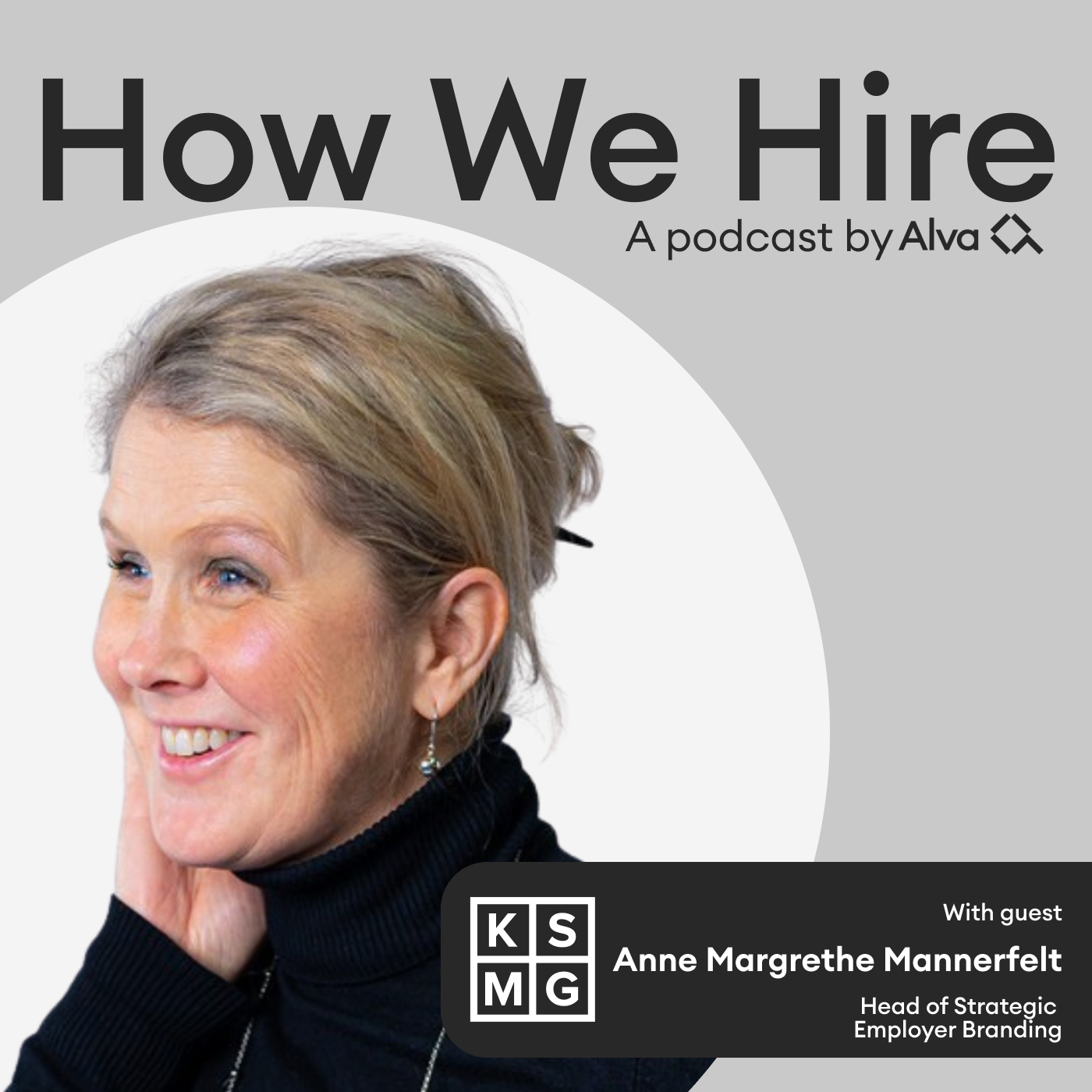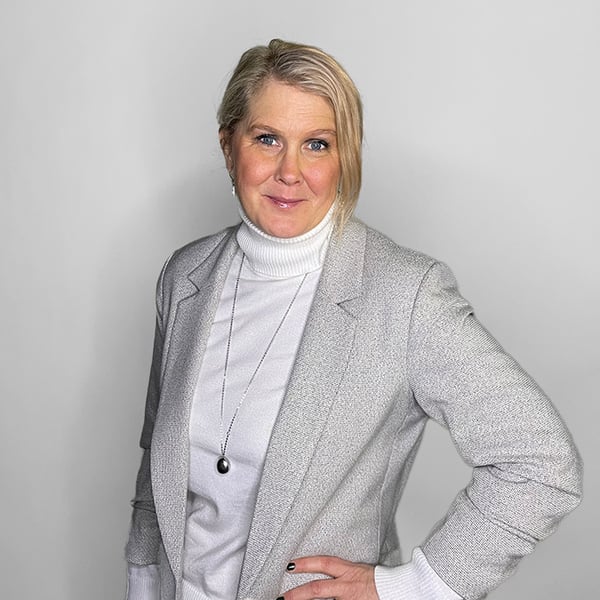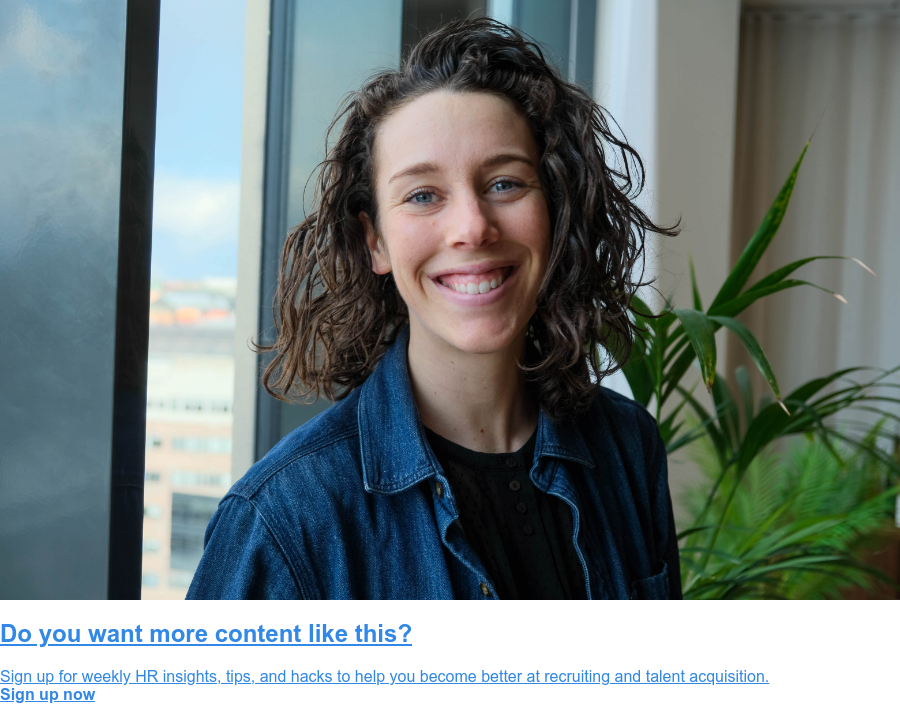How We Hire Podcast: Episode 13 Transcript
Linnea Bywall (00:00):
Amen to that. I think like at least I have learned stuff and I have taken notes and I have a to-do list. So hopefully other people that are listening will have reacted the same or it's just me that's really poor at this. That can also be the case.
Speaker 2 (00:20):
Welcome to How We Hire, a podcast by Alva Labs.
Tove Hernlund (00:23):
With me, Tove Hernlund.
Linnea Bywall (00:24):
And me, Linnea Bywall.
Speaker 2 (00:26):
This show is for all of you who hire or just find recruitment interesting. Every episode we will speak to thought leaders from across the globe to learn from their experiences and best practice within hiring, building teams and growing organizations.
Tove Hernlund (00:45):
Welcome to another Episode of How We Hire, with me, Tove, events and community manager at Alva Labs.
Linnea Bywall (00:50):
And me, Linnea, head of people.
Tove Hernlund (00:52):
And our guest on today's episode is Anne Margrethe Mannerfelt, head of strategic employer branding at KSMG and has an extensive background within employer branding, communication and project management for various large corporate companies. She's definitely a CSUN expert on employer branding, so that's exactly what we'll focus on in today's episode. Welcome to How We Hire, Anne Margrethe.
Anne Margrethe Mannerfelt (01:13):
Thank you. It's really fun and great to be here.
Tove Hernlund (01:17):
Yeah, we're so happy to have you here and I mean employer branding, this episode is going to be all about it, but first things first, I think we need to define this. How would you define employer branding?
Anne Margrethe Mannerfelt (01:28):
To be honest, there's several definitions of employer branding and in a way it might sound weird, but in a way that's okay. I think the most important advice that I have to organizations is to have a very clear definition what employer branding is to your organization because if you don't have a general consensus what employer branding is to you and to your organization, what you want to achieve with your employer branding initiatives, it's very hard to succeed.
(02:00):
But if I were to give sort of a general definition of what employer branding is, I usually start talking about that it's really all about expectations. To set the right expectations for your future employees and for your current employees. And expectations is kind of what it's all about. Having engaged employees who are innovative and who care about the clients and who care about the coworkers need to be engaged.
(02:32):
Otherwise, you won't have that innovation or want to make the clients happy. And that comes down to expectations. If you have the wrong expectations of your job or your role or a project, it's very hard to be engaged. And I think almost everyone has experienced that, that you get an assignment or a job or a task and you don't have the right expectations, it's very hard to build up that engagement.
(03:00):
But then of course, setting the right expectations and communicating them is very, very hard and that's where employer branding comes in to be able to communicate what offer you have as an employer to future and current employees.
Linnea Bywall (03:17):
I think it's really interesting with this topic because, to be honest, I don't know a lot about it and I'm winging my way through the employer branding jungle, to be honest. As you see it, what's the common denominators? How come hiring and employer branding goes so tight together or should go tight together?
Anne Margrethe Mannerfelt (03:38):
One way to understand it or to look at it is that employer branding and recruitment really is the same sort of partnership that sales and marketing has. There was a time when sales existed without marketing. If you look back and then people will go and sort of ring people's doors and say, please buy this vacuum cleaner, or they would just place an ad for a particular product in a paper or maybe call someone and say, hey, we have a great product or service.
(04:11):
But then sort of 20, 30 years ago, marketing started to become a really big thing for organizations because people realized that, okay, if we start creating a relationship with the audience, if we start talking about why these vacuum cleaners are the best and why they can trust us and maybe we're even a company that people can trust that believe in something, then it's going to be much easier to sell that vacuum cleaner.
(04:37):
Or people might actually come and say, hey, I want to buy a vacuum cleaner without even doing any selling per se. And that's where the whole sort of inbound marketing that people talk about. Employer branding and recruitment always, it takes a few years for us to catch on with these thoughts, but it's a little bit the same principle.
(05:00):
Recruiters often have to do those cold callings or place an ad and kind of hope for the best, but if you work with your employer branding, you start sort of warming up those candidates already before you have to get to those sort of acute quick recruitments.
(05:19):
Like often, and when we talk to recruiters, when do you need to fill the role? Everyone says yesterday. So it's a smart way to work long term, plus that you have more time and more space to set those right expectations because it's not only about filling that role, but, I'm sure that you know this more than I do working with recruitment sort of all the time, but hiring someone, having set the wrong expectation and having that person leave after a short period of time is probably the most frustrating thing I imagine for a recruiter or hiring manager.
(05:56):
But if you work with employer branding in a good way and in the right way, you set those expectations. People actually sort of know what they're getting themselves into and have that first engagement that sticks throughout the employee journey.
Linnea Bywall (06:13):
That's a really good analogy. And then that brings me to, I guess my view on when I'm winging employer branding and trying to do something with that, I often see it as I don't want to oversell, so I would rather focus my employer branding initiatives on the current employees because I would much rather create something for them and then I can go out and sell that rather than over-committing and then promising something that won't be true.
(06:42):
And I guess that really holds true because you don't want marketing promoting a product that you don't have or listing features that don't really exist. So I think that's a great analogy.
Anne Margrethe Mannerfelt (06:53):
Exactly. Yes, exactly. We often talk about the difference between communication and information. So in your employer branding, so before you place the job ad, it's about communication, it's about creating a feeling, creating an engagement with your audience, so they sort of get a feel, a relationship like we do with Coca-Cola for example.
(07:20):
We don't go out and do, this is the table of contents, this is what Coca-Cola is and this is how we make it. That's not what we do when we want to sell Coca-Cola, get the brand out there. Everyone has lots of associations with Coca-Cola in one way or another.
(07:35):
Then maybe before we buy the can, we'll actually look at the contents and see sort of, okay, what is actually Coca-Cola? How much sugar is it really in there? It's a little bit the same way too. We don't have to give all the information about a role while we're doing the branding. Then it's about catching that very often emotional connection with your employer brand.
(07:58):
Then once you have that, then you can go into more detail and say, this is where you're going to be placed and this is the salary and this is all the information that you'll need before you actually decide to take that job.
Linnea Bywall (08:12):
And based on that example, would you say that it's easier for a company that has a consumer product compared to a B2B because there are more feelings towards the product or can that actually be harming?
Anne Margrethe Mannerfelt (08:25):
I love that question. I think it's so interesting. I love having that conversation with clients because as you say, it can help you, but it can also create a really, really big problem because people have associations with your consumer brands and not your employer brand.
(08:42):
And that can be very hard to make that switch in people's minds. I have an example, I worked with L'Oreal Europe, this is a very long time ago, but they were a very, very attractive employer among students, students within finance, especially women, marketing, very, very popular, lots of applications.
(09:08):
And then they had a huge problem with retention for people early in their L'Oreal career. People left very sort of early. Expectations, again. It wasn't sort of the ooh, cool, everything's branded and beautiful. It wasn't a kind of, because you're worth it workplace, it was just an ordinary workplace where people work with IT or finance or whatever it might be.
(09:31):
So people left disappointed and that was a huge problem for L'Oreal to go out there and say, this is who we are as an employer. So what you get is sort of the awareness. When we start talking to a new client, we always try to figure out, what is your challenge really throughout the whole employee journey, because employer branding is also a lot about the internal employer branding to get people to stay motivated, stay engaged, and stay with the company.
(10:02):
But if we look at the external employer branding, the first question is always sort of where is your biggest challenge? Where is your biggest focus? Is it to create awareness just of you as a brand? Maybe just the people, your target group hasn't even heard your brand at all, consumer or employer at all. And then you have to get your name out there.
(10:23):
And if you have a very sort of well known consumer brand, of course people know the name and then you might even start playing with it. It's not about hair here or you might joke about it a little bit.
Tove Hernlund (10:36):
You're talking about that you need to find what's the most critical blocker or challenge for a specific company. So say most organizations would probably agree that they want to keep their great employees that they already have and they want to hire really strong candidates. So if that's our quest, what's most critical to get right when it comes to employee branding to enable recruitment?
Anne Margrethe Mannerfelt (11:02):
I would say it often starts with creating the EVP, the employee value proposition. And that's a very, very good foundation to have. And more and more organizations have an EVP now and sort of know that, that's the sort of number one platform or number one tool to use for all your employer branding.
Linnea Bywall (11:23):
Before you continue, can I jump in here? And I might be stupid, but I don't get the EVP part. What do you use it for? I don't understand it. No, I'm being transparent here.
Anne Margrethe Mannerfelt (11:36):
Well, so as we said, to be engaged you have to have the right expectations. So how do you set the right expectation? Well then you have to be able to talk about who you are as an employer and you want to do that in a consistent way. So finding a consensus, finding a language, finding a tone, finding those key messages that your candidates and your employees will recognize throughout the journey.
(12:04):
Repetition is sort of the key to any successful communication. That's why you hear sort of, "Just do it," from Nike or "Because you're worth it." Something happens if you recognize the way the brand expresses itself. So when it comes to, and I mean if you talk about consumer brand, the goal is basically to sell that sort of can.
(12:29):
With employee branding, it's so much more. It's about attracting candidates, it's about getting them to actually apply, it's about getting them to have a quick onboarding so they start being productive within the company. It's about them staying engaged, staying loyal.
(12:46):
So the brand and what the brand wants to communicate is a little bit more complicated and needs to consist a little bit more. And what we do when we create the EVP is that we look at, okay, what is important at a workplace? What do you want from an employer? And that can vary of course between different organizations, but there are some things that is important basically to everyone.
(13:11):
And the first one is the leadership and trust between leaders and employees. That's super, super important. So what kind of leadership can you expect here? What kind of support can you expect at this workplace from your leaders? So that's one area that we want to be able to say, what is your offer when it comes to leadership and how you treat your employees?
(13:36):
The second one has to do with culture, this whole big, big word, but I mean specifically when I talk about culture this way is the relationship between employees. Can I feel like I can be myself here? Is it friendly? Is there a lot of laughs? Is it challenging? Is it really smart people who always want to have sharp conversations even when they're having lunch or what kind of environment is it here?
(14:06):
And then we have development and development opportunities, which is increasingly important. And then the fourth one is about pride, which is the golden nuggets I think for engagement and for employee branding. What makes you proud to be here? What makes you sort of leave work and be like, wow, we are doing something here. Finding that.
(14:32):
And that's sort of generally what makes a great workplace. So when we start working with EVP, we want to see, what does that mean for this particular organization? What is your offer within these different areas? Once you have those different areas, then everyone will know that this is how we talk about leadership, this is how we talk about our culture from recruitment campaigns, from always on communication to actually dialogues between that recruiter and the candidates.
(15:04):
And then of course let it live throughout the internal employee journey. So you continue to reinforce the choice that your employees make because I mean we all choose our job every day. And then of course that's, you have the different areas, but then you also want to write your employee branding story.
(15:27):
Some people call them manifests, little bit depending on what tone of voice the company has. And then you have the overall tagline, the sort of just do it, but for the employee brand.
Linnea Bywall (15:38):
Thank you for explaining for me since I don't understand this. But I think what I struggle with is in my mind, wouldn't the majority come up with kind of the same EVP?
Anne Margrethe Mannerfelt (15:52):
If you don't do your homework, they would all look the same. To develop an EVP takes at least three months and there's a lot that goes into it. We have five criteria that steers us in every work that we do when it comes to EVP, and in general employer branding. And the first one is that it needs to be true.
(16:15):
So like you said before, it needs to mirror the employee experience and not only the sort of ambassadors who love the company that we always use to say wonderful things about us, but really the true employee experience. So in our methodology we do a survey where we ask all the employees what their experience are within these areas that I talked about before, and being brave enough to be very honest there.
(16:45):
So if something comes up with a leadership for example, or people they might be, I don't know, growing super fast and becoming international and there's a challenge with the culture because they're changing, be honest with that in the EVP, that's what sort of creates the right expectations and the credibility.
(17:05):
So that's the first one, to be true. So we have the survey and have the quantitative data, but then we also have focus groups or interviews to really sort of dig into what does it mean when you say it's flexible here. We can never write flexible in an EVP because then it's sort of, no one hears that word anymore. You need to explain what it is.
(17:26):
So that's the first criteria, true. The second one is distinct. So that's a little bit has to do with your question and there you have to do your work. You have to identify who are your recruitment competitors. And that in itself can be an interesting conversation with a client because they will immediately start saying this sort of business competitors and it's like, no, it's your recruitment competitors. So for IT for example, it's sort of all the banks need IT and their recruitment competitors are not necessarily the banks, it's going to be the IT consultants.
(18:02):
So identifying those recruitment competitors and then really doing your homework, looking, what did they communicate, what is their offer, how do they express it? And also where do they express it? So what channels are they in so we know how can we position ourselves compared to their recruitment competitors.
(18:23):
And then the third criteria is relevant. So sort of finding out what's important to the target group. This is where it comes in, making personas that many have heard about, really how do we speak to this target group in a way that's a lot of our sort of industry colleagues will call that criteria attractive.
(18:45):
I don't think attractive is as important as relevant because very much sort of also the true criteria. So what is important is more important than being attractive, if you know what I mean. And then anchored internally. And that has to do with the management team and knowing what the strategy is for the company, what is the business plan?
(19:09):
Where are we going? What are our values? What is our vision? What is sort of our leadership principles? So we build that into the EVP. And then the fifth one is that it's sustainable. So we want to be able to, if you create the recruitment campaigns, it doesn't have to be so sustainable because then it's about sort of, let's get people into this trainee program or let's fill these specific roles, but in the EVP, we want to at least have the ambition for it to last for a few years.
(19:40):
That said, that's very challenging in today's world. So my advice now is to have a look at your EVP on a yearly basis. Not to necessarily change it, but just to see does this still meet the five criteria.
Linnea Bywall (19:58):
I'm not sure if you can tell by the sound, but I'm taking notes.
Tove Hernlund (20:04):
I have a couple of followup questions for you, Anne Margrethe. The first one is, I mean, so you said we should revisit it more often, but I think something that we need to clarify as well is who should be responsible for the EVP?
(20:17):
Is it like the HR department? Is it the leadership team? Who within an organization should take the responsibility to own this?
Anne Margrethe Mannerfelt (20:26):
Very good question. Also depends on the organization I would say. But the best results you'll always get if you have a steer group with both communications and HR. It is both an HR and communications strategy. Super, super important. Communications know so much about how to brand and knows about the organization's overall brand and how it sits with the employer brand.
(20:56):
So very, very important. But in cases where the communications department fully own the EVP, that doesn't sit well either because there's so much that we need to know from the HR. The target groups that we have, our future employees and our current employees are very different from our consumers or clients, and of course having the whole employee journey perspective.
(21:24):
So that's ideally. I mean we have clients when the leadership team goes in and sort of owns the EVP, that's great because lots of things will happen with that, but that's very seldom the case. What often is good is to have sponsors from the leadership team.
(21:41):
So that can be a question that we might ask in the beginning, first almost like demand from the client to have in the project team both the communications and HR represented, but then to set who's your sponsor within the management team. But you have, I mean, and this topic started to have ... I will never forget the first time that I had a meeting with a global employer brand manager.
(22:09):
I loved it. This was Deutsche Bank in London 2010, I think. And there weren't many roles then. And that was wonderful because then she would have both communications and HR people working in her team. And I'm like, oh my god, this is the future. But you'll see many big organizations will have employer branding sort of director who works with both HR and communications. And that's of course ideal.
Tove Hernlund (22:41):
If you're a small company then who's never worked with employer branding before, should you start with the EVP? Is that a reasonable way to start or is that too big of a project? Is there other things that you should try to get started with just to get started? Or should you start by going big?
Anne Margrethe Mannerfelt (22:59):
If you're a company with sort of 20, 25 employees and you want to grow to having 50, 60 employees within a couple of years or three years time, if you're that sort of aggressive growth company, my recommendation is actually not to do an EVP because it is an investment in both time and money and often, you don't really have what you want to have in place in order to know what your offer will be.
(23:32):
So I would say where are you going, really having sort of that business plan, doing your homework in all the other areas, values, vision, mission, all of these sort of, some people say when I say, oh, values, mission, vision, leadership principle, they're like, oh god, it's just again, words on the wall, what are we doing?
(23:52):
And it can be words on the wall and don't have it if that's your aim. But if you really truly know the value of these strategic messages of these strategic documents, then they're really, really good. You just have to sort of know the different vision, really know where you're going as a company, get all the employees on board, this is what we want to achieve.
(24:16):
Mission is our why, this is why we exist. Get everyone on board with that. Values is how we interact with each other and with a client. It's sort of the rules in the ballpark, people call it. These things are super important for an organization to have both a good culture and be successful with whatever business that you're doing.
(24:38):
And you don't get those rights immediately when you start the company. So my advice would be to get that in place, get the employees to work for a little bit longer, so when you want to the employee experience, they actually have an experience. So that would be my recommendation to wait a little bit.
(25:01):
I think you should probably be 40 or 50 employees before it's worth really doing the EVP. Before that, I would say put your money into having a really good recruitment concept so you can still have that sort of consistent message and consistent promise throughout the candidate journey. But I will put your money there because it's very likely that you want to become bigger, most do that come into these sort of conversations.
Tove Hernlund (25:32):
I think that's wise advice. I mean I was number 14 at Alva. We are a completely different company and I mean we often joke about, ah, but that was three companies ago because things have changed so much.
(25:44):
So it would've made zero sense to have an EVP because it's a different company. On I guess that topic, if either you're not ready for the EVP or you haven't figured it out yet, guilty of that one or you have it, but you also want to find the little, the hacks, do you have a list on how to hack employer brand? What's your suggestions or initiatives that you've seen that has worked really well?
Anne Margrethe Mannerfelt (26:15):
I think finding out a little bit before you start producing content would be my advice. If you don't have the time or the resources to do the whole survey and everything that you want to sort of find out to make the EVP, do that in a mini format for whatever you are going to do.
(26:39):
So use the five criteria, but in a mini format. People want to know what it's really like at the company. That's sort of a basic truth. So don't let your sort of HR manager or even the CEO, unless it's a super, super, super, super charismatic CEO, don't let them take up too much space. Let the employees take up the space because people want to be able to hear what it's really like and to sort of identify with them so you get the truth, the true criteria.
(27:10):
Have a little look at what other people are doing because you might be able to take up space if you know, maybe even without doing the EVP, if you know that this is something that's in our pride or in our mission and what we want to achieve in the world, if that's something that's strong and it's something that is unique for you, really put your energy there.
(27:32):
And then relevant, talk about what's relevant to your audience. This is sort of the content marketing principles, but in your communication you are not the most important person. It's the receiver that is the most important person. Think about it as a date. I haven't dated in a very long time, but when I did and you sort of met a guy, super good looking, very interesting, does surfing in the free time and also have this fantastic career, that person will never be interesting unless he wants to know who I am.
(28:12):
And it's the same thing. Don't go out there as an employer and just like, ooh, we're this, we're that, blah, blah, blah, unless you know it's interesting to the person that you're talking to. And then try to be as concrete as possible if you have flexibility.
(28:28):
What is flexibility? I mean it could be anything. To me as a mom, it's about being able to drive my son to various football fields all the time and then be able to go back and work after dinner, answer those emails. To some of my young colleagues, it's about being able to travel to Brazil and sit and work for my laptop there.
(28:54):
To me that's a nightmare because I would never be able to manage the logistics if I had to go to Brazil. But both of us, we can't hear flexibility because it means nothing. So whenever you have those sort of work-life balance or flexibility or even development, try to be as concrete as possible, then it will start meaning something and show it with the sort of real employees.
(29:19):
So that's the stories that I would advise you to put out there and try to figure out the truth and what's relevant and be distinct. And then when it comes to being on LinkedIn or being on social media, find out where your target audience is. I mean I'm constantly amazed when I learn from my colleagues who know everything about this, about where the target group is, they're not even know Facebook anymore, the young talent, they're on Instagram, Snapchat, and especially TikTok.
(29:54):
So if that's where they are, that's where you want to be. And employers are surprisingly hesitant or scared to be in these new social media or new, I'm sure there's even something after TikTok that my colleagues are now working with, but really keep up to date with what's going on and be brave enough to be out there because that's where your target group is.
(30:21):
So often I'm out talking with clients who safely stick to LinkedIn, safely stay and think, oh, we're doing Facebook and think that they're kind of a little bit out there doing it, but they're so late on the ball. So everyone's already left Facebook.
(30:36):
LinkedIn people are still on of course, but there you might be actually wanting to talk to more blue colors. They're not there. So kind of be where your audience is and then work with all the tools to measure and use the data when it comes to activating your employee brand because you can do wonders, you can do so, so much if you measure your activities.
Tove Hernlund (31:04):
If you do successful employer branding work, how can you see that in your data?
Anne Margrethe Mannerfelt (31:11):
My main advice is to take the whole employee journey into account. So don't forget about those internal KPIs. This is often quite sort of challenges to build a business case and to explain internally. But I would say every single KPI within the organization can be improved and affected by a successful employer branding strategy.
(31:39):
Everyone, I mean this is not only because I work with it, but people working with employer branding has most important job within any organization because when you think about it, it creates that really important engagement and loyalty and like we said before, if you have engaged employees, they're going to have happier clients, they're going to have more effective ways of working, they're going to be innovative.
(32:03):
And those are sort of the main KPIs within a company. So helping your colleagues internally to make that link and say, what's your KPI for client satisfaction? And linking it to the employer branding work that we do via engagements. And that's of course almost everyone has an employee engagement survey. That's super important for employee branding, and to link those two.
(32:30):
Anyone who has an employee satisfaction survey, I would say scrap that because satisfaction is not what we're aiming for. We're aiming for engaged. No one wants a satisfied employee. I'm being very harsh here, but it's very sort of if you're satisfied, there's no action in that, it's not ambitious, then you're just leaning back and going like, oh, I'm satisfied. Thank you.
(32:54):
You want the drive. So internally linking it to the overall KPIs that you have as a business, and then if you move a little sort of earlier in the employee journey, measure the pre-boarding, measure the onboarding, and that can be done with a sort of evaluation surveys. It can also be measured if you have, sales is probably most easy to measure. How quickly are they actually delivering?
(33:23):
If you have a good employee branding, if you start communicating what the job is and the expectations, you'll have it quicker. If you have a good pre-boarding where you actually start putting some information in there, your new employee will be super engaged.
(33:39):
So it's not about engaging the new employees to keeping that engagement up. And then when it comes to measuring in the early phases of the employee journey, sort of the candidate's journey, then I would suggest that you use the recruitment funnel model both when it comes to deciding where to focus your initiatives, how to put your content together, but then of course to measure your activation parts.
(34:07):
So how do you move your candidates from the awareness phase to the engaged phase to the act phase. Our clients will always be, but what KPIs should I set? What's good? And that's a little bit sort of how long is a string? It's very hard to benchmark before you started doing it, but once you've started doing it, you can always sort of compare and improve to your last results.
(34:37):
But measuring the conversion and measuring sort of how well you're doing in the awareness phase and how you're doing in the engage phase and then linking to your recruitment KPIs.
Tove Hernlund (34:48):
If we look into the future a bit, I mean you said it before that 20 years ago there were no roles within employer branding except for very future oriented companies. Now that has changed. It's a given area in any larger organization, very often it's someone that specifically owned that role, et cetera. How would it look in five, 10, 20 years from now? What's the future of employee branding?
Anne Margrethe Mannerfelt (35:19):
I think the world is changing so much. So I think that not thinking that, okay, I've done my EVP, I'm done, I'm going to let it be this still platform for five years, it's not what we're going to do. I think EVP is going to be a consistent moving platform.
(35:38):
I think people are becoming better at also using the EVP, like you said in the beginning, well how do I use it? A very common and very, very sad [inaudible 00:35:48] is that organizations put a lot of effort, a lot of money creating beautiful EVPs and then no one knows what to do with it.
(35:56):
And that's maybe the saddest thing in my work when I hear about an EVP that's stuck in a drawer somewhere or on an intranet somewhere, that truly makes me sad.
Linnea Bywall (36:07):
That could so be me. That's why I haven't created one so I don't mess up and put it in a drawer.
Anne Margrethe Mannerfelt (36:12):
Don't put it in a drawer. Don't do it if you're just going to put it in a drawer. Then put your money somewhere else. And I think the key to avoiding that is to have a plan from the beginning to sort of when you plan the EVP project, the end is not when it's done. That's the start.
(36:31):
And then seeing, how do we create content from this? How do we use it for our different units or our different regions? How do we educate the recruitment team so they know how to use it and how to work with employer branding? That's very, very important because otherwise it just becomes sort of a very dead document somewhere and no one needs that.
Tove Hernlund (36:58):
And I think bringing up the analogy you used in the beginning with sales and marketing, so if we see employer branding as marketing, they will need to provide sales, in this case, the recruiters with the content, the stories so that they can tell that story and make use of it, I guess, to set the right expectations, get more qualified candidates in, keep them in the funnel, convert them more easily, and then not having to backfill as many roles because the people will actually stay around.
Anne Margrethe Mannerfelt (37:28):
There's going to be more and more focus on the current employees and how to retain them and keep them engaged. And if we compare again to sort of how branding and marketing works with the client or consumer brands, it's not that people stop caring about the clients as soon as they're in.
(37:49):
I mean, what company would be like, we have a really big important client here. Perfect. They're in now, they're buying from us, so we're just going to stop communicating with them. And no one does that. You have huge CRM departments knowing that it's much more expensive to lose a client and to win a new client.
(38:11):
So it should be exactly the same principle for employer branding. The current employees are very, very important. It's much more of a problem to lose an employee than to win an employee. And that's also become now with the great resignation after Corona, that's really become something that ... I love it because I've been trying to say this for a long time.
(38:37):
It's a hard world out there, but I love it that it's become a topic that people talk about. So really sort of knowing the employee journey, internal communications. I think is going to become a much more important role. Not just updating the intranet, but actually having a sort of strategic position more and more of a strategic important role. And the internal communications is going to be linked very closely with the employer branding.
Linnea Bywall (39:06):
Amen to that. I think at least I have learned stuff and I have taken notes and I have a to-do list, so hopefully other people that are listening will have reacted the same or it's just me that's really poor at this. That can also be the case, but at least I'm happy.
Tove Hernlund (39:22):
It's time to wrap this episode up. Thank you so much for joining us, Anne Margrethe, and it's been such a pleasure having you with us. We've both learned so much. Me, and Linnea will be back with another inspiring episode of How We Hire in two weeks. Make sure to subscribe via Spotify or Apple Podcast so you never miss an episode. And if you think two weeks is too long, make sure to check out alvalabs.io for all of our webinars and training sessions as well. Bye for now.







